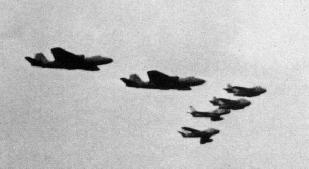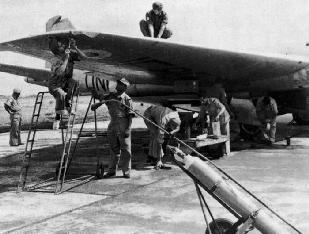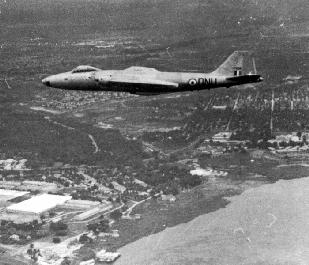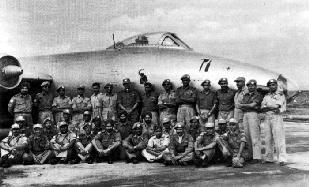The story of the first Indian Air Force Contingent to the United Nations Force in Congo in 1961.
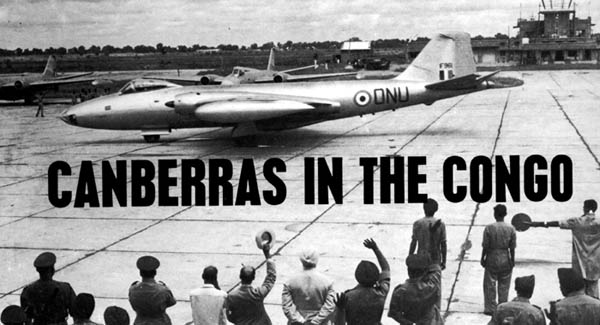
Belgium’s 75-year colonial rule of the Congo ended abruptly on 30 June 1960. The transfer of power to an untrained and inept central Government was far too rapid; disillusion sprawl through the civil population and, more dangerously, the Armed forces, as the rosy promises of these new politicians failed to materialise. In an attempt to stem the pending chaos, and perhaps with more than a twinge of guilt. Belgium intervened, hut with calamitous results, and the prosperous province of Katanga seized the opportunity to break away and declare itself an independent State. The principal personalities involved were Hammarskjold, Kasavubu, Lumumba and Tshombe – (all now dead). Today, the history they made makes fascinating yet complex reading. This short article tells of the involvement of the Indian Air Force in those stirring events.
There is no doubt that the United Nations intervention in the Congo, made at the request of the accredited legal Government, with the objectives of bringing about the early withdrawal of Belgian military forces, bringing Katanga back within the fold, and maintaining law and order, was to become the most difficult and complicated peace-keeping mission ever undertaken by the international body. In India, Prime Minister Jawaharlal Nehru was quick to respond to the initial appeal for help, and immediately released Major General Inderjit Rikhye for a command appointment. In August 1960, Dag Hammarskjold, the UN’s secretary-general, made a personal plea for the secondment of Rajeshwar Dayal to head the whole UN operation. Following the loan of these and other key personnel, a later request for assistance by armed troops and military aircraft was received by the Government of India, and help was again immediately granted.
| Two IAF Canberras flying in formation with a pair of Swedish J29s and a pair of Ethopian F-86 Sabres – a photograph that epitomises the nature of the United Nations effort in the Congo. |
The request to the Indian Air Force was for ground support aircraft, and the Hunter was at first considered. This was changed to the Canberra, however, despite the fact that the UN decreed that no bombs would be carried or dropped. This decision was made for three main reasons: firstly, the Canberra was armed with four 20mm cannon with 535 rounds per gun; second, it had long endurance and a great operational range, and third, a navigator and airborne navigation aids such as Green Satin were considered essential for the task in view of the poor weather and lack of ground aids. No.5 Squadron (“Tuskers”) equipped with the Canberra B(I) Mk.58 interdictor bomber was to provide six aircraft, aircrew and ground support personnel. Led by the CO, Wg. Cdr. AIK Suares, the first four Canberras left their base at Agra on 9 October 1961 for the Congo, flying by way of Jamnagar, Aden and Nairobi; four USAF C-124 Globemasters transported the 150 NCOs and airmen of the ground party, plus support equipment.
| Servicing proceeds at Leopoldville |
On arrival at Leopoldville, Wg. Cdr. Suares reported to the United Nations Air Commander, Air Commodore Morrison (seconded from the Royal Canadian Air Force). The Air Commodore had by this time an odd assortment of aircraft under his command, including, among others, six F-86 Sabre fighters from the Ethiopian Air Force, six Saab J 29s of the Royal Swedish Air Force, a full squadron of sixteen Fairchild C-119 transports from the Italian Air Force — whose crews frequently found urgent reason to return to their home base at Pisa in Italy for a quick visit — and a combined UN Dakota squadron crewed by members of various air forces, including those of Argentina and Brazil, and commanded by Wg. Cdr. G.B. Singh of the Indian Air Force.
Accommodation was provided for the Canberra party some miles away at Limit B, and little time was lost in settling into this new environment and, more important, getting to know the area from the air. The intensive flying program covered low-level sorties at 500 ft (153 m) and often lower, formation flying, night flying and in general “showing the flag” and making a presence felt. The Indian Independent Brigade Group had, earlier in August, launched “Operation Rumpunch” to take into UN custody the many foreign mercenaries serving with the Katanga Gendarmerie. This was followed, in September, by the attempt to seize Katangese airfields and communication networks, and protection of refugees. Towards the end of November came news of a massive build-up by the Katangese Army in Kolwezi, 130 miles (209 km) NW of Elizabethville. then held by a Battalion of the Indian Brigade. Indian Army personnel were being ambushed, and air strikes were being made by a lone Fouga Magister thought to be flown by a French mercenary named Jacques Delen. This aircraft was being used to fly over Kamina, then held by the 2nd Jats of the Indian Army, to bomb hangars and the transport aircraft which arrived from Leopoldville on supply missions. These aircraft, incidentally, came from a remarkable airline called the Seven Seas Company, with aircrews made up of Americans, Swedes and Britons. Their main task was to fly in full fuel drums aboard Curtiss C-46 Commandos.
The First Attack on Kolweizi
By early December, the United Nations Air Commander had finally been ordered to take action and the Canberra crews from No.5 Squadron were summoned for the breifing. Within six hours, the six Canberras took-off, in three waves of two aircraft each, led by Wg. Cdr. Suares. The first pair were to attack and destroy the airfield at Kolwezi while the second and third waves were each given a series of grid map references for areas where Katangese troop concentrations and convoys had been reported. It was a formidable task, since the targets were over 800 miles (1 290 km) distant and the route to the target was blanketed in cloud. The plan of action was to find a lake which lay to the west of Kolwezi and then map-read over the final leg to the airfield, using the Green Satin airborne navigation aid. The moment of truth came as Wg. Cdr. Suares dived, keeping a wary eye on his altimeter, to break cloud 400 ft (122 m) above the surface of the lake! A quick check of lakeside features, and he turned in to the airfield — and what a target!
| One of the IAF Canberras, attached to the United Nations force in Congo flies over Kolweizi |
A light transport aircraft had just taken off and rapidly disappeared into the clouds hanging low above the runway. Two large transport aircraft were refueling by the control tower and, parked behind the main runway, were some six or seven light transport/communications aircraft. Well off to one side in a jungle clearing was the dreaded Fouga Magister which had bombed Elizabethville and Kamina.
“I took out all the light aircraft with my 20mm cannon on the first low level pass attack,” Suares recalls,” whilst Flt. Lt. P. Gautam, flying the second Canberra, destroyed the Fouga Magister. We made a rapid turn and, on the second pass, I concentrated on the heavy transports and control tower. During the second run in I saw that we had stirred up a hornet’s nest of activity. Katangese soldiers were running about everywhere, and scores of muzzle flashes told me that we were flying through a curtain of bullets. On the third and last pass I saw that all the parked aircraft and the control tower were ablaze, so we both hammered away at the stacked fuel barrels, the adjacent hangars and the buildings.”
The Canberras then made good their escapes in the clouds and set courses for Kamina Airfield, which was to be their new base. On arrival they learned that the raid had been a total success. The other four Canberras had all homed in on the lake, found their targets and dealt with them to great effect. After rapid refueling and rearming, the Canberras returned to the fray, knowing that they enjoyed complete air superiority; all the Katangese aircraft at Kolwezi and Jadotville had been destroyed.
The Second Attack on Kolweizi
Wg. Cdr. Suares led his Canberras back to Kolwezi for their second strike. “On my first pass I flew low over the bulk petrol stores without firing, and was relieved to see people scurrying out of the way before I turned around for a second pass, firing a one-second burst. Since our cannon shells were loaded alternately with high explosive and incendiary heads, only one hit was needed to “whoosh” off the entire line of storage tanks. On the third pass I concentrated on anything that had survived the previous attacks. As before, we were flying through an angry hail of small arms fire, and as I pulled up I heard the ominous bang as my aircraft was hit in the nose area. My navigator, Flt. Lt. (now Air Commodore) M.M. Takle was struck in the upper thigh. I pulled up through cloud and set course for Kamina, set the controls to automatic and climbed down and forward to render first aid. He was in great pain, and I had to apply a tourniquet above the gaping wound before returning to the controls. On landing he was rushed to the UN hospital and subsequently received the award of the Vir Chakra (VrC).”
For the next week, the Indian Canberras made numerous armed reconnaissance sorties. The war was heating up, and on December 9th, Wg. Cdr. Suares was summoned to Elizabethville for briefing. “I hitched a lift in a transport aircraft into the middle of the battlefield area, where I met General K.A.S. Raja, Operational Commander of the Indian Brigade. He was in the thick of the battle and there were shells howling over our heads as he pointed out on the map the areas he wanted neutralised; and then took me forward to point out the exact targets on the ground! On return to base, I briefed Sqn. Ldr. P.P.S. Madan, Flt. Lt. (now Gp. Capt.) Dushyant Singh, Flt. Lt. S.C. Singh (now an Air India Captain) and Flt. Lt. Gautam for the operation. The Canberras made an immaculate raid, with Flt. Lt. Dushyant, despite heavy and accurate anti-aircraft fire, posting his cannon shells straight into the post office with devastating effect. This building housed the main communication centre for the Katanga capital, and its destruction was to have far-reaching effects. The other aircraft in the raid strafed road convoys, ammunition dumps and various strong points — much to the subsequent delight of General Raja.
The IAF squadron continued to fly operational sorties around Elizabethville, often in direct contact with Forward Observation Officers who talked them on to their various targets, which, expertly camouflaged, were often almost invisible from the air. The Katangan troops and foreign mercenaries fell back, and Gorkha units followed up their attacks with other infantry troops from the Indian Brigade. The fire support given by the Canberra squadron was rated a major factor in the battle for Elizabethville. The following weeks, into January 1962, found Canberras flying a heavy program of armed recce sorties, looking for targets of opportunity and striking convoys wending their way along the enemy lines of communication. The weather was, as ever, unpredictable, to say the least. From a few hundred feet clouds would build up rapidly into a solid wall towering to some 40,000 ft (12,200 m), vicious electrical storms were encountered and visibility in the driving rain was appalling.
| The Indian Air Force contingent photographed before ending its Congo assignment. Notice the “Tuskers” emblem of No.5 Squadron, right below the cockpit. |
The combat pressures gradually died down from this point on, but operational photographic recce missions still had to be flown, and visual confirmation on the state of vital targets such as bridges, troop movements and concentrations was reported back to the commanders of the land battle. The main action took place from late November 1961 until early January 1962; soon after Wg. Cdr. (now Air Commodore, retd.) Suares handed over his aircraft to Wg. Cdr. (now Air Marshal, retd.) S. Jena, to return to Agra and resume command of the main component of his squadron – the Fighting Fifth. He was later to receive a bar to the VrC he already held from a previous campaign. The Vayu Sena medal was won by Flt. Lt. (later Wg. Cdr.) P. Gautam and five officers and NCOs of the ground party in an action in which the Indian Canberras provided the UN with its only long-range air support force.
Source:
“Canberra’s in the Congo” in Chopra, Pushpindar Singh, William Green and Swanborough, Gordon. Eds. The Indian Air Force and its Aircraft. IAF Golden Jubilee. 1932-82. Ducimus Books, London, UK.
Note:
Gautam was to later receive a Maha Vir Chakra in the 1965 war and subsequently a Bar to the MVC in the 1971 War. He died in a MiG-21 crash on 25 November 1972.
